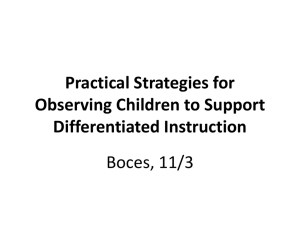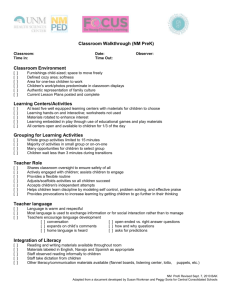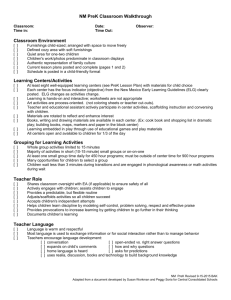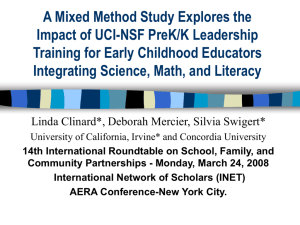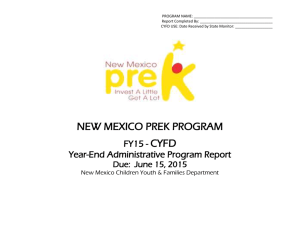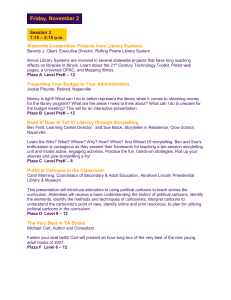New Mexico PreK Curriculum Policy Brief
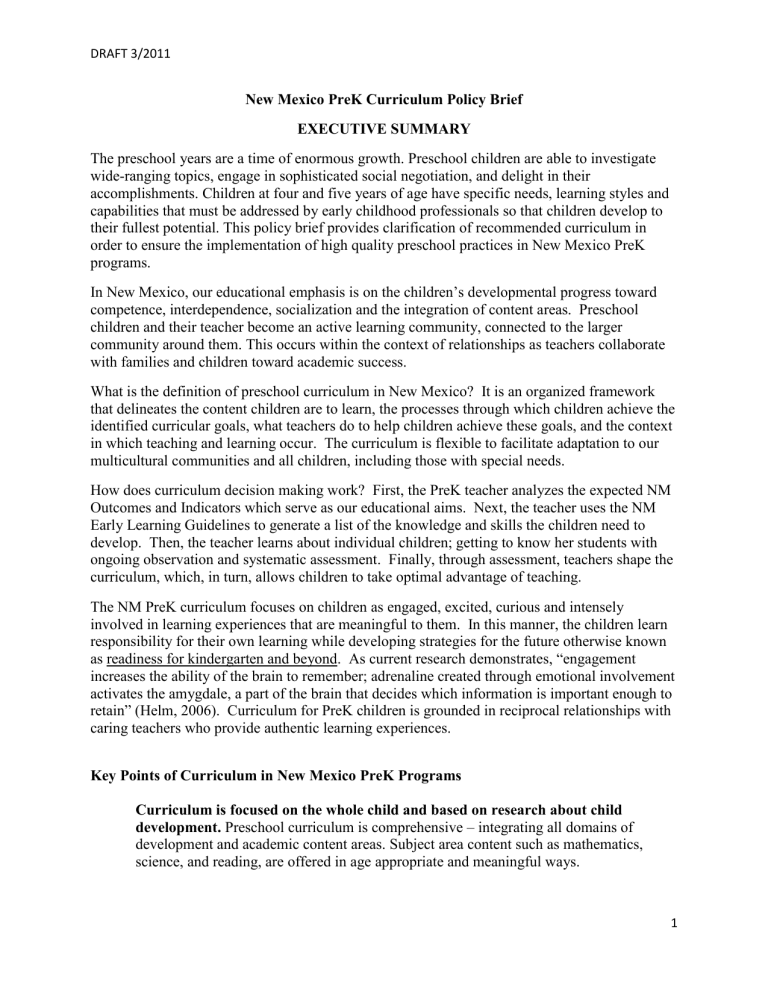
DRAFT 3/2011
New Mexico PreK Curriculum Policy Brief
EXECUTIVE SUMMARY
The preschool years are a time of enormous growth. Preschool children are able to investigate wide-ranging topics, engage in sophisticated social negotiation, and delight in their accomplishments. Children at four and five years of age have specific needs, learning styles and capabilities that must be addressed by early childhood professionals so that children develop to their fullest potential. This policy brief provides clarification of recommended curriculum in order to ensure the implementation of high quality preschool practices in New Mexico PreK programs.
In New Mexico, our educational emphasis is on the children’s developmental progress toward competence, interdependence, socialization and the integration of content areas. Preschool children and their teacher become an active learning community, connected to the larger community around them. This occurs within the context of relationships as teachers collaborate with families and children toward academic success.
What is the definition of preschool curriculum in New Mexico? It is an organized framework that delineates the content children are to learn, the processes through which children achieve the identified curricular goals, what teachers do to help children achieve these goals, and the context in which teaching and learning occur. The curriculum is flexible to facilitate adaptation to our multicultural communities and all children, including those with special needs.
How does curriculum decision making work? First, the PreK teacher analyzes the expected NM
Outcomes and Indicators which serve as our educational aims. Next, the teacher uses the NM
Early Learning Guidelines to generate a list of the knowledge and skills the children need to develop. Then, the teacher learns about individual children; getting to know her students with ongoing observation and systematic assessment. Finally, through assessment, teachers shape the curriculum, which, in turn, allows children to take optimal advantage of teaching.
The NM PreK curriculum focuses on children as engaged, excited, curious and intensely involved in learning experiences that are meaningful to them. In this manner, the children learn responsibility for their own learning while developing strategies for the future otherwise known as readiness for kindergarten and beyond. As current research demonstrates, “engagement increases the ability of the brain to remember; adrenaline created through emotional involvement activates the amygdale, a part of the brain that decides which information is important enough to retain” (Helm, 2006). Curriculum for PreK children is grounded in reciprocal relationships with caring teachers who provide authentic learning experiences.
Key Points of Curriculum in New Mexico PreK Programs
Curriculum is focused on the whole child and based on research about child development.
Preschool curriculum is comprehensive – integrating all domains of development and academic content areas. Subject area content such as mathematics, science, and reading, are offered in age appropriate and meaningful ways.
1
DRAFT 3/2011
Curriculum reflects the social and cultural context of children’s development and learning.
Preschool professionals recognize, understand, and facilitate a variety of ways for children to express their developmental achievements.
Curriculum and assessment are integrated as teachers observe and document children’s performance which informs the next step in teaching and organizing learning opportunities.
Play and investigation serve as the most important and primary modes for learning.
As children engage with interesting and provoking materials, teachers interact with them, providing support, asking questions, observing, and offering challenges so that children are learning new skills and concepts and applying and adapting ones that are already established.
Teachers are intentional as they plan for learning that is engaging, interesting and challenging. Teachers individualize instruction as they implement their curricular plans.
Teachers and children engage in the learning process together.
Teachers work closely with children as they explore and discover concepts through high quality play experiences, interesting and engaging large and small group times and in daily routines.
Teachers provide assistance or “scaffolding” to help children stretch to perform at a higher level than what each can do independently.
National Recommendations for Curriculum in Preschool Programs
National recommendations, termed “Developmentally Appropriate Practice,” are supported by a strong foundation of research in child development. These practices include some of the following key aspects:
• Developmentally appropriate practice requires both meeting children where they are— which means that teachers must get to know them well—and enabling them to reach goals that are both challenging and achievable.
• All teaching practices should be appropriate to children’s age and developmental status, attuned to them as unique individuals, and responsive to the social and cultural contexts in which they live.
• Developmentally appropriate practice does not mean making things easier for children.
Rather, it means ensuring that goals and experiences are suited to their learning and development and challenging enough to promote their progress and interest.
• Best practice is based on knowledge—not on assumptions—of how children learn and develop. (NAEYC Key Messages 2009, page 1)
2
DRAFT 3/2011
New Mexico PreK embraces the recommended goal for curriculum to “promote positive outcomes for all young children.” (NAEYC and NAECS/SDE 2003, page 2) By identifying key elements of curriculum, and by integrating the New Mexico PreK Observational Assessment
Tools with these elements, PreK teachers will be clear in ways to effectively educate the children in PreK classrooms and can “ …implement curriculum that is thoughtfully planned, challenging, engaging, developmentally appropriate, culturally and linguistically responsive,
[and] comprehensive…”(NAEYC and NAECS/SDE 2003, page 2)
Comprehensive Curriculum
Curriculum in preschool programs goes beyond activities outlined in a teacher’s manual.
Curriculum cannot be contained in a box with a particular set of materials or a focus on one domain (such as literacy). And, curriculum cannot be left to happenstance. It must be planned and based on sound knowledge and research about child development.
Preschool curriculum is comprehensive - integrating all domains of development and academic content areas. It provides a framework to guide teachers in the following:
∙organizing the classroom environment
∙making sure that learning is at the core of all they do with children
∙planning for learning experiences that are interesting and challenging for children
∙determining activities in which they will lead the children
∙figuring out ways to take advantage of teachable moments as children choose what to do and how to go about it
The result of a planned preschool curriculum should be education that is joyful and engaging.
The enthusiasm of young learners is contagious and their curiosity knows no bounds. Effective early childhood professionals relish the opportunities to work with such highly motivated children. They build on the strengths of their students, offering them opportunities to be successful and to continue to work toward their fullest potential. As stated in the 3 rd edition of
Developmentally Appropriate Practice:
Excellent teachers know… it’s both joy and learning…they go hand in hand…Teachers are always more effective when they tap into this natural love of learning rather than dividing work and enjoyment. As some early childhood educators like to put it, children love nothing better than ‘hard fun.’ (Copple and Bredekamp 2009, page 50)
The goal for New Mexico PreK curriculum is just such joyful learning and challenging fun. To meet this goal, teachers must be intentional. They must plan carefully and individualize instruction as they implement their plans. The following graphic illustrates these goals.
3
DRAFT 3/2011
Curriculum in New Mexico PreK Programs
New Mexico PreK curriculum is based on a developmental- interactionist approach where the adult and child engage in the learning process together. The teacher and educational assistant are critically important in the delivery of curricular goals, working closely with children as they explore and discover concepts, building understanding of the world around them.
“Developmental interaction can be contrasted with behavioral approaches to classroom instruction…the developing child and the adult are viewed as actively constructing meaning…”
(Nager and Shapiro 2000, page 26) The child is not just passively receiving new information.
Instead, learning is seen as occurring in a social environment with adults providing assistance or
“scaffolding” to help children stretch to perform at a higher level than what each can do independently (Vygotsky 1978).
Teachers know how and when to scaffold children’s learning…then, they gradually reduce the support as the child begins to master the skill, and set…the stage for the next challenge.
1.
Teachers recognize and respond to the reality that in any group, children’s skills will vary and they will need different levels of support. Teachers also know that any one child’s level of skill and need for support will vary over time.
2.
Scaffolding can take a variety of forms; for example, giving the child a hint, adding a cue, modeling the skill, or adapting the materials and activities….
3.
Teachers can provide the scaffolding (e.g., the teacher models the skill) or peers can
(e.g., the child‘s learning buddy models); in either case, it is the teacher who recognizes and plans for each child’s need for support and assistance. (
NAEYC
Position Statement 2009 , page 19)
4
DRAFT 3/2011
In New Mexico PreK curriculum, particular attention is paid to the indicators of effective curriculum identified as follows:
•
Children are active and engaged.
•
Goals are clear and shared by all.
•
Curriculum is evidence-based.
•
Valued content is learned through investigation, play, and focused, intentional teaching.
•
Curriculum builds on prior learning and experiences.
•
Curriculum encompasses critical areas of development, including children’s physical well-being and motor development; social and emotional development; approaches to learning; language development; cognition and general knowledge; and subject matter areas such as science, mathematics, language, literacy, social studies, and the arts.
• Professional standards validate the curriculum’s subject matter content.
• The curriculum is likely to benefit children. (NAEYC and NAECS/SDE 2003, page 7)
The Elements of New Mexico PreK Curriculum
For New Mexico PreK, eight elements of curriculum have been identified and the integration of these elements is highlighted and explained.
5
DRAFT 3/2011
New Mexico PreK curriculum focuses on the integration of the following teacher actions which take place in an on-going, cyclical process:
1.
Planning of activities and play experiences that are age-appropriate for preschool children
2.
Observation of children in action and documentation of what they say and/or do
3.
Reflections based on these observations so that teachers can assess each child’s performance and individualize curricular strategies to better meet the needs of each and every child
4.
Planning of activities and play experiences that are both age-appropriate and individually appropriate for the children in the PreK classroom
5.
Observation again to determine children’s success and needs
These processes take place in the context of a rich, play-based, intentional environment.
Explanations of each of the elements follow here.
Goals Based on the New Mexico Outcomes and Indicators
At the heart of curriculum in New Mexico PreK are the New Mexico PreK Outcomes and
Indicators (which have now been incorporated into the New Mexico Early Learning
Guidelines to show a continuum of development from birth through the kindergarten year). They are the goals about which all elements of curriculum revolve. They provide the foundation for learning and give reasonable expectations supported by research in child development. They are integrated into every aspect of the preschool day. They inform teachers as they plan, as they implement activities, as they guide children through play experiences and as they engage with children in daily routines. Because of this goaloriented approach to curriculum, assessment is woven into every aspect of the preschool day. Teachers are continually observing their children in a variety of experiences, documenting those observations and collecting data to support conclusions about how each child is progressing.
Integration of Learning in All Activities
Therefore, no activities or experiences are planned that do not have a learning component inherent in them.
Even meals, transition times and outdoor explorations are opportunities for teachers to integrate the Outcomes and Indicators. Children demonstrate their skills and capabilities in all that they do – not just in specified assessment tasks or content-related activities. They use language as they play with friends outdoors, converse at snack time and transition from activity to activity. They problem solve, focus attention and apply their skills as they build with blocks, put together puzzles, look at familiar books and role play in dramatic play scenarios. They count and use quantity as they set the snack table, take attendance or determine how many children are in line to wash their hands. They recognize alphabet letters as they see their names in print on helper charts and name cards and often attempt to write letters as they participate in meaningful play such as going grocery shopping or writing notes to each other.
6
DRAFT 3/2011
Well-Organized Environment
Teachers plan for activities and experiences that will encourage children to use their skills and capabilities as well as challenge them to learn new concepts and try something that is just beyond their present level. Planning such a range of experiences for children requires teachers to be thoughtful and intentional in setting up the environment so that the right materials and organized areas are available. In New Mexico PreK, recommendations for organizing the environment come from the Early Childhood
Environment Rating Scale (ECERS-R). Areas of the classroom are organized so that specific activities can take place in each area. The specific activities include
Fine Motor
Art
Music/Movement
Blocks
Sand/Water
Dramatic Play
Nature/Science
In addition, the New Mexico PreK Lesson Plan Format identifies the following learning areas that teachers set up, and for which they plan and identify goals for children’s engagement on a weekly basis:
Blocks
Art
Math Center
Dramatic Play
Class Library
Science Center or Sensory Table
Manipulatives
Writing Center
Teachers are invited to include one other learning area (such as music/movement or listening center) on the lesson plan format. They also have discretion in room organization, depending on the space, availability of furniture and materials, etc.
Recommendations for room arrangement and provision of materials again are based on the Early Childhood Environment Rating Scale (ECERS-R). PreK Consultants and others regularly review the classroom environment using the criteria of the ECERS-R and
7
DRAFT 3/2011 provide feedback to teachers so that the environment is providing high quality opportunities for the children.
Ample Time for Play and Investigation with Adult Support
Play continues to be an important aspect in the recommendations for best curricular approaches in preschool programs.
Particularly for younger children, firsthand learning—through physical, mental, and social activity—is key. At every age from birth through age eight (and beyond), play can stimulate children’s engagement, motivation, and lasting learning (Bodrova & Leong 2003). Learning is facilitated when children can
“choose from a variety of activities, decide what type of products they want to create, and engage in important conversations with friends” (Espinosa 2002, 5).
(NAEYC and NAECS/SDE 2003, page 6)
Therefore, the daily schedule of a PreK classroom includes ample time for children to engage in play and investigation with adult support.
Because of the careful planning of the environment, learning areas and activities, the play times (both indoors and out) have purpose. They are tied to identified goals (taken directly from the PreK
Outcomes and Indicators). And, teachers interact with children, providing support, asking questions, and offering challenges. Throughout these interactions, teachers observe children closely to determine each child’s capabilities.
In this way, teachers are ensuring that children’s play experiences are at high levels with benefits to the children. In high level play, children are learning new skills and concepts and applying and adapting ones that are already established. The play times in PreK classrooms are not “free-for-alls”. Rather, they are times when children can become deeply engaged, work alone or together, and interact with adults who provide new vocabulary, help them determine problem-solving strategies and provoke their thinking.
Balance of Adult-Guided and Child-Guided Activities
As teachers facilitate play experiences, they may be following the child’s lead in the activity. The child directs his or her actions and the teacher helps in whatever ways are beneficial. Teachers also plan and lead activities and experiences for the children. The balance between child-direction and teacher-direction is important. And for young children, this balance may lean more heavily toward child-direction than for older children. Early childhood educators continually decide in what instances they will follow the child’s lead and in which moments to be in a more directive role themselves.
Developmentally appropriate teaching practices provide an optimal balance of adult-guided and child-guided experiences. “ Adult-guided experience proceeds primarily along the lines of the teacher’s goals, but is also shaped by the children’s active engagement; child-guided experience proceeds primarily along the lines of children’s interests and actions, with strategic teacher support.”
(NAEYC Position Statement 2009, page 17)
8
DRAFT 3/2011
Relationships with Children and Families
When they begin their PreK experience, many children may be leaving their home environment for the first time. Relationships with caring adults at the PreK program will make this transition go more smoothly for children and enhance their overall experience.
“From birth, a child’s relationships and interactions with adults are critical determinants of development and learning.” (NAEYC Position Statement 2009, page 17) And, establishing relationships with each child’s family members strengthens the relationship between teachers and child. All adults in the child’s life are working together in partnership to assure the child’s optimum growth and development.
Teachers establish positive, personal relationships with each child and with each child’s family to better understand that child’s individual needs, interests, and abilities and that family’s goals, values, expectations, and childrearing practices…Teachers talk with each child and family (with a community translator, if necessary, for mutual understanding) and use what they learn to adapt their actions and planning. (NAEYC Position Statement 2009, pages 17-18)
The richness and diversity of heritage, culture and home language for New Mexico’s
PreK families is to be welcomed and celebrated in all aspects of the PreK program.
Teachers regularly invite families to participate and share in a variety of ways to enrich the children’s PreK experience. And, attention is given to each child’s home language as well as his or her acquisition of English.
The Integration between Curriculum and Assessment
The commitment to authentic, observational assessment in New Mexico PreK is well-grounded in research and theory. Using a criterion-based approach, PreK teachers watch and listen as children participate in activities and experiences throughout the PreK day. They document observations for the purpose of reflection and planning as well as to assess each child’s capabilities and progress. They collect portfolio documentation on key Essential Indicators to capture tangible evidence of children’s progress and growth to share with families and to help with curricular planning. The New Mexico PreK Observational Assessment Tools are based on recommendations for best practices.
To best assess young children’s strengths, progress, and needs, use assessment methods that are developmentally appropriate, culturally and linguistically responsive, tied to children’s daily activities, supported by professional development, inclusive of families, and connected to specific, beneficial purposes. The purposes of doing assessment are: (1) making sound decisions about teaching and learning, (2) identifying significant concerns that may require focused intervention for individual children, and (3) helping programs improve their educational and developmental interventions. (NAEYC and NAECS/SDE
2003, pages 1-2)
In New Mexico PreK curriculum, assessment does not stand apart. Teachers include Indicators in all aspects of the PreK day, identifying the ways they will incorporate them into play experiences, daily routines and large and small group activities. Teacher observation related to the PreK Outcomes and Indicators and the documentation of children’s performance related to
9
DRAFT 3/2011 the Indicators are on-going. Teacher reflection about these observations informs the teaching process and assists teachers in determining the most effective curricular strategies.
Academics, Play and Teacher Intentionality
Where do academics fit into NM PreK curriculum? How are content areas such as language arts, mathematics, science and social studies addressed? How are children prepared to succeed in kindergarten and the elementary grades? And what is the role of teachers in bringing about student success in the PreK year? These important questions must be addressed in this policy brief as well.
Learning is at the core of NM PreK curriculum,. The content comes from the expectations identified in the New Mexico PreK Outcomes and Indicators. Well-grounded in research and child development and reviewed by stakeholders throughout the State of New Mexico, these
Outcomes encompass the following seven domains:
Physical Development, Health and Well-Being
Literacy
Numeracy
Aesthetic/Creativity
Scientific Conceptual Understanding
Self, Family and Community
Approaches to Learning
The seven domains include traditional academic content areas (Literacy = Language Arts;
Numeracy = Mathematics; Scientific Conceptual Understanding = Science; Self, Family and
Community = Social Studies) and readiness skills (such as working cooperatively with others, taking personal responsibility for belongings and focusing on a task for extended periods of time) that will prepare PreK students to enter kindergarten ready to continue learning and developing.
PreK teachers are responsible to incorporate the Outcomes and Indicators in the seven domains into all activities and experiences planned for the children. They write specific indicators as goals for play areas, for meals and transition times, for outdoor explorations, for small group and individual reading times and for large and small group activities. They choose materials and teaching strategies that will support these goals. They do not limit addressing academics to only teacher-directed activities. Instead they imbed academic goals in purposeful play experiences as well as in daily routines.
The PreK curriculum emphasizes the many benefits of high quality play for young children as stated in the Key Messages of the Developmentally Appropriate Practices Position Statement
(NAEYC 2009):
• Rather than diminishing children’s learning by reducing the time devoted to academic activities, play promotes key abilities that enable children to learn successfully. In high-
10
DRAFT 3/2011 level dramatic play, for example, the collaborative planning of roles and scenarios and the impulse control required to stay within the play’s constraints develop children’s selfregulation, symbolic thinking, memory, and language—capacities critical to later learning, social competence, and school success.
• Because of how they spend their time outside of school, many young children now lack the ability to play at the high level of complexity and engagement that affords so many cognitive, social, and emotional benefits. As a result, it is vital for early childhood settings to provide opportunities for sustained high-level play and for teachers to actively support children’s progress toward such play. (page 3)
Through play experiences as well as teacher-directed small and large group activities, teachers plan so that academic skills and concepts related to literacy, numeracy, science and social studies are included. They address academics in age-appropriate and meaningful ways rather than attempting to adapt approaches that work with children in the elementary grades In a joint position statement (1998), NAEYC and the International Reading Association offer the following recommendations for addressing literacy in preschool classrooms:
Thus the picture that emerges from research in these first years of children’s reading and writing is one that emphasizes wide exposure to print and to developing concepts about it and its forms and functions. Classrooms filled with print, language and literacy play, storybook reading, and writing allow children to experience the joy and power associated with reading and writing while mastering basic concepts about print that research has shown are strong predictors of achievement. (page 5)
Math and science are also included in PreK curriculum in accordance with recommended preschool practices. “Mathematics and science should be treated as essential components of a comprehensive, high-quality preschool program, not as extras.” (Brenneman, Stevenson-Boyd and Frede March 2009, page 1) The following components of early childhood math education are identified by Ginsburg, Lee and Boyd (2008). As PreK teachers focus not only on mathematical learning, but also on literacy, science and social studies, and as they follow the elements of PreK curriculum, they will be incorporating these components as well.
1.
Environment
The preschool classroom…should contain a rich variety of objects and materials— such as blocks, dress up area and puzzles—that can set the stage for mathematics [or literacy, science and social studies] learning.
2.
Play
We know that children do indeed learn a good deal of everyday mathematics
[literacy, science and social studies] on their own (Seo & Ginsburg, 2004). Play provides valuable opportunities to explore and to undertake activities than can be surprisingly sophisticated from a mathematical point of view…[but] play is not enough.
11
DRAFT 3/2011
3.
Teachable Moment
The teachable moment involves the teacher’s careful observation of children’s play and other activities in order to identify the spontaneously emerging situation that can be exploited to promote learning.
4.
Projects
These are extensive teacher initiated and guided explorations of complex topics related to the everyday world…
5.
Intentional Teaching
Deliberate instruction—teaching—… is a key part of ECME [Early Childhood
Mathematics Education as well as that for literacy, science and social studies]… teachers and other key professionals should… actively introduce …concepts, methods, and language through a range of appropriate experiences and teaching strategies… (pages 6-8)
The intentionality of teachers is a key message in the third edition of Developmentally
Appropriate Practice (Copple and Bredekamp 2009). Such intentionality is not limited to direct instruction. Intentionality can incorporate many teaching strategies.
Teachers possess an extensive repertoire of skills and strategies they are able to draw on, and they know how and when to choose among them, to effectively promote each child’s learning and development at that moment. Those skills include the ability to adapt curriculum, activities, and materials to ensure full participation of all children. Those strategies include, but are not limited to, acknowledging, encouraging, giving specific feedback, modeling, demonstrating, adding challenge, giving cues or other assistance, providing information, and giving directions. (NAEYC Position Statement page 18)
To effectively implement NM PreK curriculum, teachers not only plan to use specific strategies and write them on the PreK Lesson Plan Format, but they also continually adapt and decide on strategies as they interact with children. They address academic content in ways that fit the moment and appear to be most beneficial to the children. Then, they observe the impact of their planned strategy and change their approach if necessary. Teacher intentionality is central to the observation, documentation and planning process for PreK curriculum as well as the integration of academic goals and outcomes.
Conclusion
New Mexico PreK curriculum and assessment practices are based on a strong foundation of research in child development and recommendations for best early educational practices.
Curriculum and assessment are interwoven in an on-going process that requires teachers to be thoughtful, know their children and families well, and understand the best ways to facilitate young children’s learning experiences. The goal of New Mexico PreK curriculum is to provide the highest quality preschool experiences for the children of New Mexico.
12
DRAFT 3/2011
Resources
Brenneman, Kimberly, Judi Stevenson-Boyd and Ellen C. Frede, Math and science in preschool: policies and practice.
Preschool public policy brief March 2009 Issue 19. New Brunswick NJ:
National Institute for Early Education Research.
Copple, Carol, and Sue Bredekamp, eds. 2009. Developmentally appropriate practices in early childhood programs serving children from birth through age 8 . 3 rd
ed. Washington DC: National
Association for the Education of Young Children.
Ginsburg, Herbert P., Joon Sun Lee and Judi Stephenson Boyd. Mathematics education for preschool children: What it is and how to promote it . Social policy brief Volume XXII, Number
I 2008. New York: Society for research in child development.
Nager, Nancy and Edna Kaufman Shapiro. 2000. Revisiting a progressive pedagogy: The developmental-interaction approach . Albany, NY: SUNY Press.
The National Association for the Education of Young Children (NAEYC). 2009.
Developmentally appropriate practices in early childhood programs serving children from birth through age 8 . Position statement.
http://www.naeyc.org/positionstatements/dap
The National Association for the Education of Young Children (NAEYC). 2009. Key messages of the position statement.
http://www.naeyc.org/positionstatements/dap
The National Association for the Education of Young Children (NAEYC) and the International
Reading Association (IRA). 1998. Learning to read and write: Developmentally appropriate practices for young children . http://www.naeyc.org/ positionstatements.
The National Association for the Education of Young Children (NAEYC) and the National
Association of Early Childhood Specialists ( NAECS) in the State Departments of Education
(SDE). 2003. Where we stand on curriculum, assessment, and program evaluation . http://www.naeyc.org/ positionstatements.
Vygotsky, Lev. 1978. Mind in society: The development of higher psychological processes .
Cambridge, MA: Harvard University Press.
13
